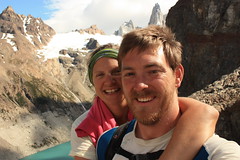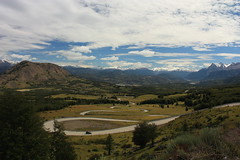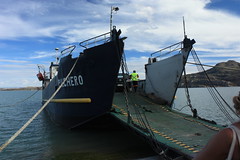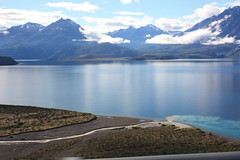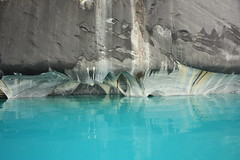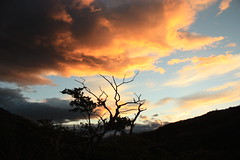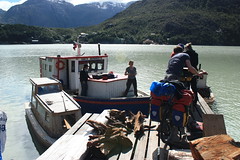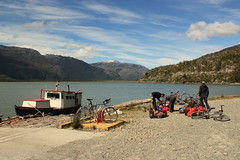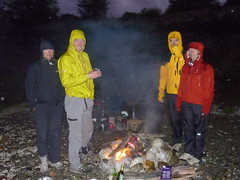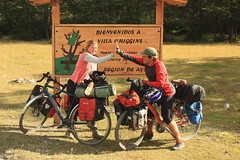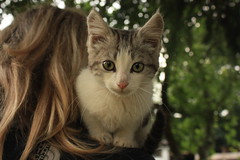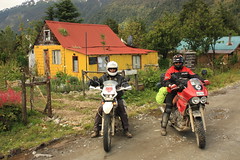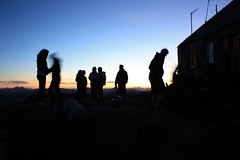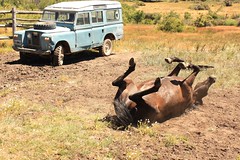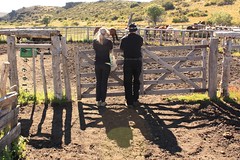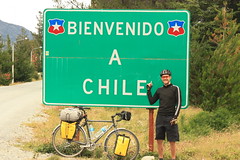
The bad weather was back so we left Bariloche in see-your-breath cold, under a low sky and through a constant drizzle of rain. Despite this, the scenery was amazing and the road was perfect. We cycled a smooth paved route through deep valleys alongside gun-metal grey lakes. The mountains were high and snow-capped and we could occasionally view the glaciers of Tronador, the mountain we had trekked a few days before. The rain and mist completely changed the atmosphere of the scenery; the lakes and rivers were no longer inviting but looked moody and dark.
Besides the usual climbs, the road was predominantly downhill and we enjoyed long stretches of fast free-wheeling as we approached the next town,
El Bolson. We expected big things from this town because other travellers had spoken so highly of it's laid back atmosphere, and even the Lonely Planet described it as 'a refreshing antidote to Bariloche's relentless commercialism'. It's famous for being a hippie hang-out since the seventies, and for it's amazimg artisanal food and beers. The food and beers were amazing, some of the best we've had, but the hippies were a let-down; just the usual middle-class trustafarians from the cities, slumming it for the summer, smoking roll-ups and juggling. Catherine said that hippies were 'her people', but she says the same thing about Indians so I don't believe her. The best thing about the place by far were the family-sized portions of home-made cakes, the fresh breads filled with lamb stew, and the 'taster selections' of micro-brewery beers, where you get a half pint of everything on the menu. Lovely.
The countryside around El Bolson is stunning and the next town slightly to the south was possibly what Bolson used to be before it became commercialised in it's own way; sleepy, picturesque and no bloody hippies. After a long up-and-down ride through the mountains, Ruta 40 bends sharply to the east and leaves the mountains behind for open praerie. This is the land that Butch Cassidy and the Sundance Kid settled in after escaping the States, and it looks (in places), every bit like the wild west. With the flatter terrain however, came the wind, and we struggled initially with fierce gusting cross-winds that blow you off the road one minute and under a passing truck the next. There was one stretch however, where we were amazingly lucky; the wind was square in our backs and the road was straight, well paved and with a slight downhill gradient. Even on flat ground, without peddling, the wind would push you along at about 40-50km/hr. We saw a little more of Argentina's wildlife, more armadillos and even a skunk. All dead, flattened by the traffic. We've even seen plenty of dead birds at the roadside, the most confusing scene was way back on day four of the whole trip when we saw a dead cow lying next to a dead condor. If, like me, you've ever wondered who would win in a fight between a cow and a condor, there's your answer: it's a dead heat.
After a while the praerie got a bit dull though (no wonder Butch and Sundance went back to robbing), and the tailwind became a headwind. We had optimistically hoped to reach Esquel, 160km from Bolson, but we stopped about 25km short and camped in the desert, under a bridge, lulled to sleep by the sound of trucks thundering overhead.
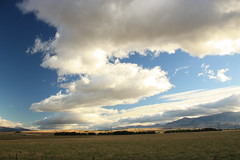
The wind raged all night but we woke to an amazing sunrise, and the journey to Esquel was quick and painless. We passed through Esquel, only stopping for supplies, and headed for Trevelin, the furtherst west Welsh settlement in Argentina; they landed on the Atlantic coast, settled Puerto Madryn and Trelew before heading west up the Chubut river towards the Andes. The result is an entire valley bisecting Argentina where everybody speaks Welsh. Just as the Swiss settled in the mountains and Butch and Sundance settled on the praerie, aspects of the countryside that we were cycling through looked spookily similar to the black montains. The rainy day helped to hide the more incongruous snow-capped 2000m peaks. In the town, the streets have names like Davies and
Jones, the buildings look out of place for Argentina, and there are tea-houses everywhere. We stayed for the night in one of the
nicest hostals we've ever seen, on a hill overlooking town, and went straight out for the famous Welsh afternoon tea. Catherine was in her element with a four-pinter pot of loose-leaf tea (apparently the Welsh are 'her people' too), and a selection of home made cakes, scones and jams. Trevelin and it's tea houses are a bit like a living museum where they out-Welsh the Welsh; people really do speak the language here, but it was a nice litle reminder of the UK, so we weren't complaining.

The sunrise the following morning and the clearer skies made me realise that we'd been a bit unkind in describing Trevelin as '
a bit like Wales'; Once the clouds had lifted to reveal the full mountain range, the town and the
surrounding countryside is absolutely spectacular. I would happily own a sheep farm here (although possibly not as happily as a Welshman).
A short distance south of town the road heads west into the Andes and our pass into Chile became visible through the higher mountains. The weather got bad enough to distract Catherine from the road and she fell again, this time breaking the lugs holding her rear rack to the bike. Catherine was fine but the break is a serious problem; without the rear racks we have no way of carrying anything significant on her bike - I'm beginning to think that the falls are pre-meditated. We patched it up with cable ties and duct tape and headed for the border post.
As expected, the Argentine military post couldn't care less that we were leaving for Chile, whereas the Chilean border guards were a different story. They are paranoid about pests, and therefore have very tight controls on the importation of fruit. We dutifully declared two bananas, two apples, an orange, some very nice but very dangerous unpasturised artisanal cheese and a chorizo. We were told to eat the lot or loose it, so we joined the little group of people having a fruit picnic at the border. Some poor old guy was carrying loads of food for a party and ate the lot out of principle, staring defiantly at the border guard whilst he ate a whole bag of prunes, 10 plums, and countless apples and oranges.
We met a nice Canadian tourer called James at the border so we cycled into Futaleufu with him to look for accommodation and to try to book a rafting trip for the following day. The scenery changed almost instantly as we entered Chile and we began to see the first hints of the rainforests that we expect further to the south. In the town square we also met another tourer from Spain called Joan who had arrived in Argentina to climb Aconcagua. When he came back down he decided not to be a backpacker and instead bough a bike to cycle to the south of the country. James decided to continue south as it was still early, but we stayed in town with Joan to camp for free in the back yard of the rafting company that was going to guide us down 'The Terminator' the following day. The Rio Futaleufu is world-famous for it's rapids and draws rafters and kayakers from all over the world. The river includes class VI rapids, only accessible to guides and professionals, but you can take to the river as a punter and raft the class IV+ and V's, the fastest water available to non-guides. Me and Joan signed up for the full day for a trip taking in rapids called, 'The Terminator', 'Son of Terminator', The Khyber Pass', and 'Asleep at the Wheel'.
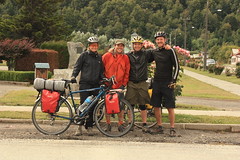
To prepare for the day ahead we went out for a drink, but Futaleufu is a sleepy mountain town with not too many options. Our first choice was shut so we looked around until we saw some lights and heard music coming from a bar called 'Scorpions'. The curtains were drawn and the door was locked. We knocked and a lady opened the door, just a bit, looked us up and down and asked what we wanted. We said beer, she thought about it, looked us up and down again, and let us in. It was dark, full of smoke and cowboys, yet only a few exotically made-up women. There was also a huge screen playing the DVD of a Chilean band singing love songs to girls dancing in bikinis and cowboy boots. We were in a brothel. It was however the only place serving beer, and apart from the occasional request for a dance with Catherine, we were left to ourselves, so we stayed for a very interesting evening. Drinking in a Chilean brothel is now well and truly ticked off our 'list of things to do before you die'. Next up is riding a monkey.
